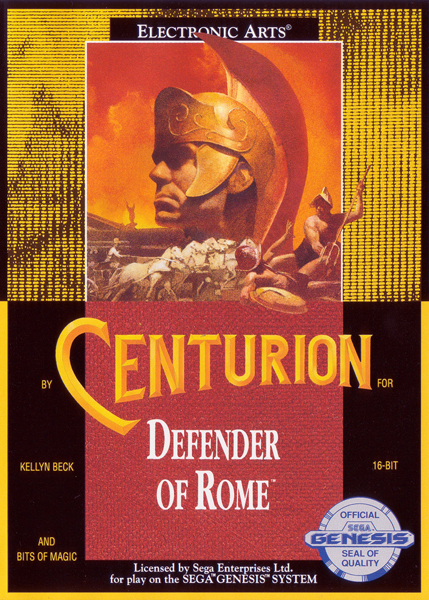
Centurion: Defender of Rome
System: Genesis
Release Date: July 1991
Developer: Bits of Magic
Publisher: Electronic Arts
Genre: Strategy
Make the vast swaths of Europe, the Near East, and Northern Africa yours to rule in Centurion: Defender of Rome! In the year 275 B.C., you stand atop the seven hills of Rome and look across your domain. Though you are an inexperienced officer now, you hope to make your Legion the poster child of the Roman Army. There will be many land and sea battles in front of you before you can take your rightful place as Caesar! Do you have what it takes to unite the Roman known world?
You begin with your legion standing in the province of Italia, and there are a couple dozen other provinces sectioned off, ripe for the taking. Pressing the A Button on Italia will take you to a town menu. Here, you can look at your legions, set tribute, take part in a chariot race for fun and profit, build a fleet, set tribute policy for all of your provinces at once, look at your list of provinces, end your turn, or go back to the world map. Clicking on other provinces you own will give you most of those choices, but will replace the chariot race with hold games, and tribute policy with plunder.
Pressing the B Button on your legion shows where they can move. They are able to move by and to any adjacent province, and when they land on one that you don’t control, you are given information about the area and then taken to a conversation with the leader of that province. Here, you can try to sweet talk your way into an alliance, or you can head to the battlefield. Most provinces can be allied with, if you meet the army size and rank requirements and talk to them just the right way. If you make a mistake, you can withdraw and try again next year, or go to war. Occasionally, between turns there will be a random occurrence that either helps or harms you.
The land battle screen asks you to choose your battle formation from balanced, wedge, strong right, and strong left. You then get to see the opposing army and their battle formation. Next, you will choose a strategy that depends on your formation. Your troops will then act based on the orders you gave. Once the battle begins, you can give a directional movement order to each individual unit, as long as they are within your general’s sphere of influence. Different generals have different voice ratings. Any troops outside will not respond to commands, until your general moves close to them. This design choice is a massive flaw. There are not enough initial strategy orders for you to be able to effectively fight all the different armies and formations you come across. Not being able to command your army from the outset and give them detailed instructions makes the land battles not very strategic. I found most battles were best fought in a balanced or wedge formation in a stationary line. After the enemy made contact, I would then hit the melee button and release the legion to fight every man for himself.
When you are trying to conquer a province in battle, you want to kill as few of the enemy as possible. Many troops will begin to retreat before they have been killed, sometimes right when they’re attacked. Enemy units are also more likely to flee after their general has been killed, but this goes both ways. Any troops still alive after battle are immediately available to be added to your legion. The manpower in each province will grow over the years until it reaches a cap. I found late in my playthrough that when a province is taken, and you go take it back, the survivors appear in the available soldier pool again, allowing you to replenish legions without having to wait years. As your rank in the army increases, you are given access to cavalry legions with new equestrian units and consular armies that are much bigger in size. These make defeating the more difficult opponents to the east and your rivals in Carthage more manageable.
You need to fund your legion raising, fleet building, and games celebrations somehow, and there are three ways. First, you earn tribute each year from the provinces you own. You can make this tribute very high or very low, but realize they will revolt if it’s too high. You can also plunder the province and immediately add to your talents, at the cost of a spurned populace. Or you can take part in chariot races and bet on yourself. The last choice is the easiest and also most time consuming way of going about it. You can choose from a light, medium, or heavy chariot, each costing five extra talents. You are then able to bet on yourself, up to 100 talents per race. At the very least, you can double your bet each year.
I can see the Chariot Race as being the least favorite part of the game for most people. The first time you take part, I bet you die in the first turn and need to be carried off on a stretcher, as long as they don’t throw you too far and take off without you… I took several tries before I got the proper technique down and I can replicate it every time as long as I’m paying attention. The B Button whips your horses for extra speed, which you should get up to the sustainable maximum right away, as long as you aren’t running into the other chariots. Otherwise, you’ll be draining the stamina of your horses and the hit points of your chariot. Turns can be taken at a speed up to where it is marked safe. You have to press down to decelerate as soon as you see your driver moving to the right, I usually slowed down as I passed the third large pillar on the map. While you’re in the turn, your chariot will push out to the outside of the track, unless you hold left on the d-pad. Once you’re no longer in the turn, you are free to whip your horses ragged again. If you follow these instructions, you should be able to win the race in about two minutes. And you’ll do this each turn to keep your coffers full, meaning this will get incredibly boring as you play.
This money can be used for building a fleet of ships to control the Mediterranean Sea and even move out toward Britain. Ship battles are easy to win if you know the strategy. You need a huge fleet if you want to go to sea. I’m talking dozens of Triremes, Quinqueremes, and Galleons. Each ship holds a certain number of soldiers, which you want to fill the holds with. In battle, you press up to increase your speed, steer with left and right, and shoot your catapult straight from the bow of your ship. As you get close, both ships begin to shoot arrows at one another, and you can ram and board your enemy by pressing the B Button. Here, your soldiers will fight the enemy automatically. If you win, hope you have more boats in your fleet than they do, because if you don’t, you can still lose!
It took me several false starts before I figured out that tactics really don’t matter and volume is the quickest way to victory. Even if you lose a battle, you can send a fresh legion in to pick apart the remnants. Try to win through diplomacy so you don’t have to fight every battle, except against marauding bands and ruthless barbarian provinces. Keep betting on the ponies to keep your coffers overflowing and tax rates low. And if you play your cards right, when you march into Egypt, you can spend a night with Cleopatra herself. Just don’t be a fool and insult the Queen or you’ll be thrown out on your butt with another lonely night.
Graphics: 2.0
The gameplay graphics are nothing to write home about, though there are a few neat looking scenes here and there.
Sound: 1.5
The music is sparse, but loops quickly, making it unpleasant. The sounds in the chariot race are rather annoying.
Gameplay: 2.0
The grand strategy is more interesting than the limited control battles and tedious chariot races.
Difficulty: 2.0
I feel like most strategies are just doomed to fail, but once you know what to do, it becomes a cakewalk.
Fun Factor: 3.0
If I didn’t have to race so many times to make money, I would have had more fun, but I played for hours at a time to finally become Caesar.
Overall Rating: 2.1
Centurion: Defender of Rome earns a C. I used to play this game a lot and I enjoyed it enough though I was terrible at it. I still like it, but there is a lot of room for improvement.
